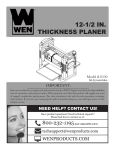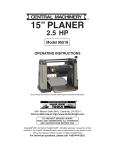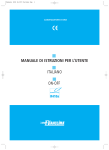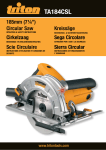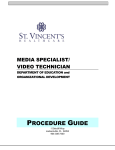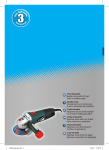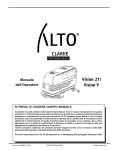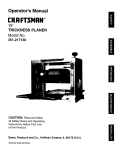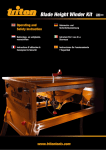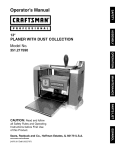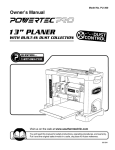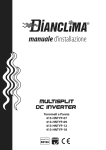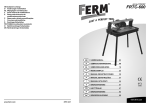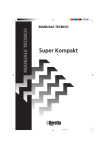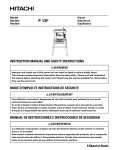Download Manuale Pialla TPT125
Transcript
Planer / Thicknesser 317mm / 12.5" Operating and Safety Instructions Gebrauchs- und Sicherheitsanweisung Bedienings- en veiligheidsvoorschriften Istruzioni Per L’uso E La Sicurezza Instructions d’utilisation et consignes de sécurité Instrucciones de uso y de seguridad www.tritontools.com TPT 125 Thank you for purchasing this Triton tool. Please read these instructions: they contain information necessary for safe and effective operation of this product. This product has a number of unique features and, even if you are familiar with similar products, reading the instructions will help you get the full benefit of its unique design. Keep these instructions close to hand and ensure all users of this tool have read and fully understand them. CONTENTS Specifications 2 Symbols 2 Know your product 3 Safety instructions 4 Assembly 6 Safety6 Preparation7 Operation 8 Maintenance 9 Troubleshooting11 Warranty 12 Declaration of Conformity SPECIFICATIONS Model no: TPT125 Voltage: 220V - 240V Power: 1100W / 1.5hp Cuts per min: 17,500min-1 Cutter head speed: 8750min-1 Planing height: 3.2mm x 152mm (0.1 x 6") Planing width: 317mm / 12.5" Table size: 317mm (12.5") x 238mm (9.37") Insulation: Earthed Net weight: 29 kg (63.9 lbs) SYMBOLS GB ENVIRONMENTAL PROTECTION Waste electrical products should not be disposed of with household waste. Please recycle where facilities exist. Check with your local authority or retailer for recycling advice. WARNING. To reduce the risk of injury, user must read instruction manual Instruction warning. Always wear ear, eye and respiratory protection. Conforms to relevant legislation and safety standards. Contents / Specifications / Symbols Class I construction (Protective earth). KNOW YOUR PRODUCT 1 2 3 13 4 5 12 14 11 6 10 15 9 8 7 19 16 18 1.Rollercase 2.Side Panel Retaining Screws 3.Elevation Scale 4.Scale Pointer 5.Dust Chute 6.Dust Chute Thumb Screws (x2) 7. Crank Handle Retaining Bolt 8.Crank Handle Fixing Cap 9.Crank Handle 17 10. In-feed Table 11. Centre Table 12. Circuit Breaker 13. On/Off Switch 14. Brush Access Cap 15. Hex Key 16. Blade Cover Panel Screws 17. Blade Cover Panel 18. Dust Chute Fixing Positions 19. Magnets Know your Product GB 3 SAFETY INSTRUCTIONS GB WARNING Read all safety warnings and all instructions. Failure to follow the warnings and instructions may result in electric shock, fire and/ or serious injury. Save all warnings and instructions for future reference. The term "power tool" in the warnings refers to your mains-operated (corded) power tool or batteryoperated (cordless) power tool. 1) Work area safety a) Keep work area clean and well lit. Cluttered or dark areas invite accidents. b) Do not operate power tools in explosive atmospheres, such as in the presence of flammable liquids, gases or dust. Power tools create sparks which may ignite the dust or fumes. c) Keep children and bystanders away while operating a power tool. Distractions can cause you to lose control. 2) Electrical safety a) Power tool plugs must match the outlet. Never modify the plug in any way. Do not use any adapter plugs with earthed (grounded) power tools. Unmodified plugs and matching outlets will reduce risk of electric shock. b) Avoid body contact with earthed or grounded surfaces, such as pipes, radiators, ranges and refrigerators. There is an increased risk of electric shock if your body is earthed or grounded. c) Do not expose power tools to rain or wet conditions. Water entering a power tool will increase the risk of electric shock. d) Do not abuse the cord. Never use the cord for carrying, pulling or unplugging the power tool. Keep cord away from heat, oil, sharp edges or moving parts. Damaged or entangled cords increase the risk of electric shock. e) When operating a power tool outdoors, use an extension cord suitable for outdoor use. Use of a cord suitable for outdoor use reduces the risk of electric shock. f) If operating a power tool in a damp location is unavoidable, use a residual current device (RCD) protected supply. Use of an RCD reduces the risk of electric shock. NOTE: The term “residual current device (RCD)” may be replaced by the term “ground fault circuit interrupter (GFCI)” or “earth leakage circuit breaker (ELCB)”. 4 Safety Instructions 3) Personal safety a) Stay alert, watch what you are doing and use common sense when operating a power tool. Do not use a power tool while you are tired or under the influence of drugs, alcohol or medication. A moment of inattention while operating power tools may result in serious personal injury. b) Use personal protective equipment. Always wear eye protection. Protective equipment such as dust mask, non-skid safety shoes, hard hat, or hearing protection used for appropriate conditions will reduce personal injuries. c) Prevent unintentional starting. Ensure the switch is in the off-position before connecting to power source and/or battery pack, picking up or carrying the tool. Carrying power tools with your finger on the switch or energising power tools that have the switch on invites accidents. d) Remove any adjusting key or wrench before turning the power tool on. A wrench or a key left attached to a rotating part of the power tool may result in personal injury. e) Do not overreach. Keep proper footing and balance at all times. This enables better control of the power tool in unexpected situations. f) Dress properly. Do not wear loose clothing or jewellery. Keep your hair, clothing and gloves away from moving parts. Loose clothes, jewellery or long hair can be caught in moving parts. g) If devices are provided for the connection of dust extraction and collection facilities, ensure these are connected and properly used. Use of dust collection can reduce dust-related hazards. 4) Power tool use and care a) Do not force the power tool. Use the correct power tool for your application. The correct power tool will do the job better and safer at the rate for which it was designed. b) Do not use the power tool if the switch does not turn it on and off. Any power tool that cannot be controlled with the switch is dangerous and must be repaired. c) Disconnect the plug from the power source and/ or the battery pack from the power tool before making any adjustments, changing accessories, or storing power tools. Such preventive safety measures reduce the risk of starting the power tool accidentally. d) Store idle power tools out of the reach of children and do not allow persons unfamiliar with the power tool or these instructions to operate the power tool.Power tools are dangerous in the hands of untrained users. e) Maintain power tools. Check for misalignment or binding of moving parts, breakage of parts and any other condition that may affect the power tool’s operation. If damaged, have the power tool repaired before use. Many accidents are caused by poorly maintained power tools. f) Keep cutting tools sharp and clean. Properly maintained cutting tools with sharp cutting edges are less likely to bind and are easier to control. g) Use the power tool, accessories and tool bits etc. in accordance with these instructions, taking into account the working conditions and the work to be performed. Use of the power tool for operations different from those intended could result in a hazardous situation. 5) Service a) Have your power tool serviced by a qualified repair person using only identical replacement parts. This will ensure that the safety of the power tool is maintained. Cutting tool safety For safety relating to protective clothing/equipment and general health hazards relating to power tools, refer to General and Electrical Safety sections in this manual Use the correct cutting tool • Ensure the cutting tool is suitable for the job. Do not assume a tool is suitable without checking the product literature before use. Protect your eyes • Always wear appropriate eye protection when using cutting tools • Spectacles are not designed to offer any protection when using this product; normal lenses are not impact resistant and could shatter Protect your hearing • Always wear suitable hearing protection when tool noise exceeds 80dB Protect your breathing • Ensure that yourself, and others around you, wear suitable dust masks Be aware of others around you • It is the responsibility of the user to ensure that other people in the vicinity of the work area are not exposed to dangerous noise or dust and are also provided with suitable protective equipment Hidden objects • Inspect the workpiece and remove all nails and other embedded objects before cutting • Do not attempt to cut material that contains embedded objects unless you know that the cutting tool fitted to your machine is suitable for the job • Walls may conceal wiring and piping, car body panels may conceal fuel lines, and long grass may conceal stones and glass. Always check the work area thoroughly before proceeding Beware of projected waste • In some situations, waste material may be projected at speed from the cutting tool. It is the users responsibility to ensure that other people in the work area are protected from the possibility of projected waste Fitting cutting tools • Ensure cutting tools are correctly and securely fitted and check that wrenches / adjusters are removed prior to use • Only use cutting tools recommended for your machine • Do not attempt to modify cutting tools Direction of feed • Always feed work into the blade or cutter against the direction of movement of the blade or cutter Beware of heat • Cutting tools and workpieces may become hot in use. Do not attempt to change tools until they have been allowed to cool completely Control dust / swarf • Do not allow dust or swarf to build up. Sawdust is a fire hazard, and some metal swarf is explosive • Be especially careful when cutting wood and metal. Sparks from metal cutting are a common cause of wood dust fires • Where possible, use a dust extraction system to ensure a safer working environment GB Safety Instructions 5 ASSEMBLY Unpacking Carefully unpack and inspect your tool. Familiarise yourself with all its features and functions. Ensure that all parts of the tool are present and in good condition. If any parts are missing or damaged, have such parts replaced before attempting to use this tool. Bench mounting • Set up the unit on a firm, flat surface so that the table is horizontal and the unit cannot tip over • When siting the tool in a permanent position, ensure that it is fixed to a rigid Fig.1 work surface 1. Use the holes in the base of the planer/thicknesser as a template to mark and drill four holes in your intended mounting surface (i.e. workbench). Secure the unit in position using large bolts, washers and nuts (not supplied) 2.If the planer/thicknesser is intended to be portable, fix a board to the base which can be easily clamped and removed from various mounting surfaces 3.Ensure bolts are long enough to penetrate the workbench or board sufficiently for a secure fix Attaching the crank handle Mount the Crank Handle (9) in position (see main image) on the right hand side of the planer: 1. Thread spring washer onto Fig.2 Crank Handle Retaining Bolt (7) 2.Fit the crank handle onto the gear screw 3.Use the bolt to secure the crank handle in position. Use the Hex Key (15) to tighten the bolt 4.Insert the Crank Handle Fixing Cap (8) to conceal the fixing Attaching the dust chute The Dust Chute (5) can be mounted for extraction of waste at either end of the planer 1. Use the 2 x Dust Chute Thumb Screws (6) to mount the dust chute onto the Rollercase (1) using the Dust Chute Fixing Positions (18) 2.Having fixed the chute in position, connect the dust extraction hose Fig.3 3.Turn the extract system on before operating the planer SAFETY GB Important guidance for safe use of this tool • Disconnect the machine from power source whenever adjusting or replacing any parts • Ensure the On/Off Switch is in the 'OFF' position before connecting the tool to mains power • Keep hands away from all moving parts • Wear eye protection and a face mask when using this tool • Make sure all mobile parts move freely and are free from interference • Keep blades sharp, aligned and correctly secured to the cutter head • Never turn the machine on with the workpiece in contact with the blades • Whenever the planer is not in use, switch off and disconnect from power • Keep the planer in good order. Follow the maintenance instructions (see 'Maintenance') 6 Assembly / Safety Circuit breaker • A circuit breaker is installed next to the On/Off Switch (13) • If excessive electric current is detected, the circuit breaker will shut off the power supply to protect the motor • Before resetting the circuit breaker check the motor, switch, and power connection for short circuit or faulty components • To reset the circuit breaker: - Press the red (0) button so that the machine is turned off - Press the Circuit Breaker Reset Button (12) PREPARATION Capacity • Workpieces must comply with the following minimum and maximum dimensions: i. Min thickness: 3.2mm ii. Min length: 125mm iii. Min width: 18mm iv. Max width: 317mm • To prevent kickback, do not use a workpiece that is warped, contains knots, or is embedded with foreign objects (nails, staples, etc) • This planer is designed for natural wood material only • Remove glue and any foreign objects from the workpiece before planing • Measure and compare results to check that the blades are correctly aligned and/or to determine the amount of correction required • If the blades need to be re-aligned, see 'Maintenance – Re-aligning the rollercase' for guidance Setting the depth of cut • To protect the motor and cutter head, the recommended maximum depth of cut for a single pass is as follows: Max Depth of Cut Width of workpiece Max depth of cut • Use the entire width of the cutter head to avoid uneven wear of blades Up to 125mm 2.38mm From 125mm up to 317mm 1.6mm Rollercase height adjustment To set the depth of cut: • The Rollercase (1) contains the motor, cutting head with blades, and the in-feed and out-feed rollers 1. Measure the current thickness of the workpiece, and compare with required thickness • Rotate the Crank Handle (9) to raise or lower the rollercase. One complete turn of the crank handle raises or lowers the rollercase 1.58mm (1/16") 2.Refer to the 'Max Depth of Cut' table above to determine whether one or more passes are required • The Scale Pointer (4) and Elevation Scale (3) provide a reading, in metric and imperial graduations, of the height of the cutter head above the Centre Table (11) – and therefore the approximate thickness of the workpiece after planing • Use the crank handle to move the rollercase up or down until the Scale Pointer (4) indicates, on the Elevation Scale (3), the finished thickness of workpiece required • The elevation scale is calibrated at the factory. For precision woodworking, it is recommended that you check the dimension with calipers or a digital thickness gauge before and after each cutting pass Checking the rollercase is level • The rollercase is aligned and checked in the factory. However, it can become out of alignment during shipping and handling • If the rollercase is not level with the Centre Table (11), this will result in a tapered cut where the thickness on each side of the workpiece differs. It can also cause uneven wear of the blade • To check that the blades are aligned correctly; run two pieces through each side (left and right) of the planer 3.If just one pass is required: 4.If more than one pass will be required: a) It is recommended that you divide the total required into passes of approximately equal depth b) For the first and any intermediate cuts, set the height of the rollercase at current workpiece thickness minus depth calculated in step (a) above c) Check measurements after each cut with callipers or a digital thickness gauge Switching on and off GB • The On/Off Switch (13) is located on the front of the planer • To turn the planer ON, press the green ON (I) button • To turn the planer OFF, push the red OFF (0) button Preparation 7 OPERATION For best results • Determine required depth of cut and final thickness of workpiece before planing. Since there is a limit to maximum depth of cut, several passes may be required to achieve final thickness • In general, thin cuts produce a better outcome in terms of smoothness of finished surface, even thickness, less kickback, less snipe, and less wear on the cutter head and motor • To prevent kickback, never make cuts deeper than 2.4mm (3/32") in one pass • If more than one pass is necessary, the rollercase must be lowered manually before each pass • Always set a thin depth of cut for hardwood, wide workpieces and workpieces with an uneven surface • Avoid wood stock with many or large knots, or with excessive twisting, cupping, or bowing • If necessary, process one side with a jointer or surface planer first to obtain at least one flat surface before using the planer • Plane both sides of the workpiece, removing half the total depth from each side. This will produce two smooth surfaces with equal moisture content and therefore a board less likely to warp when it dries naturally • Make a test cut with similar material to check accuracy of the settings before planing the workpiece • Feed the workpiece 'with' the grain whenever possible • Provide suitable support for long or wide workpieces GB Operating the planer 1. Set up the planer for depth of cut required (see 'Preparation' above) 2.Put on all safety equipment required to use this tool, including face mask and safety glasses 3.Never stand directly in front of the workpiece, stand to the side of the crank handle. and do not allow anyone to stand or cross in line with blade rotation. Kickback or thrown debris will travel in this direction 4.Place the workpiece on the In-feed Table (10), with the surface to be planed facing upwards 5.Turn the machine on and allow the cutter head to reach full speed 6.Holding the workpiece firmly, move it slowly towards and onto the in-feed roller NOTE: Never feed a workpiece into the planer via the out-feed table 8 Operation 7. Stop pushing the workpiece once it is engaged by the in-feed roller. The in-feed roller will move the workpiece automatically through the planer 8.Do not force the cut. Slowing or stalling will overheat the motor 9.Always keep your hands well away from the blades or chip ejection area while the motor is running 10.Support the weight of large workpieces as they move through the planer to stabilise the workpiece and reduce snipe 11.Move to the back of machine to receive the workpiece, Do not pull the workpiece; allow the rollers to do the work 12.If a workpiece should become jammed inside the machine: turn the machine off, remove the plug from mains supply, raise the rollercase away from the workpiece and ALLOW THE MACHINE TO COME TO A COMPLETE STOP 13.Never reach into the machine whilst it is in operation or running down 14.Use in-feed and out-feed rollers or supports when working with long workpieces 15.For precision woodworking, measure the thickness of the workpiece with calipers or a digital thickness gauge after each pass MAINTENANCE WARNING! Always ensure that the tool is switched off and the plug is removed from the power point before making any adjustments or carrying out maintenance • Any damage to this tool should be repaired and carefully inspected before use, by qualified repair personnel • Have your power tool serviced by a qualified repair person using only identical replacement parts. This will ensure that the safety of the power tool is maintained Cleaning and lubrication • After use, vacuum the planer machine to remove wood chips, sawdust and debris • Use a cleaning solution (not included) to remove resin and grease residue • Remove sawdust, wood chips and grease from chains and gears • The bearings in motor and cutter head units are factory-sealed and should require no further lubrication • Four components require regular lubrication: - Rollercase vertical screw mechanism (x2) - Rollercase lock cam - Rollercase vertical rails (x4) - Feed roller chain drive • Remove the top and both side panels to access these components • Clean the chain drive before lubrication. Use spray oil (not included) to lubricate the chain. Allow time for the lubricant to penetrate between the links, then wipe the surface of the chain dry • Remove any residues of grease from the other components, using mineral spirits if necessary, then apply a coat of light grade multi-purpose grease (not included) • The work table and extension table can be coated with a very thin coat of lubricating wax (not included) to protect the surface from rust and to facilitate smooth feed during operation Re-aligning the rollercase • Test the blade alignment by running two pieces through each side (left and right) of the planer • Measure and compare results to check that the blades are correctly aligned and/or to determine the amount of correction required Fig.4 • To correct any misalignment: 1. Turn the planer off and Fig.5 remove the plug from the power source 2.Carefully place the planer on its back 3.Remove the screws to the horizontal spindle retaining bracket on the Crank Handle (9) side of the planer. 4.Carefully disengage the gears 5.Slowly rotate the crank handle to raise or lower the rollercase as needed to re-position it on the vertical screw 6.Rotate the crank handle forward or back as required in order to correct the misalignment. Each complete turn of the crank handle will make an adjustment of 0.15mm (0.006") 7. Re-engage the gears and re-fit the horizontal spindle retaining bracket 8.Carefully sit the planer upright again 9.Carry out a test run to check the rollercase is now level 10.Repeat the correction process if further adjustment is necessary Checking and replacing the blades Inspecting the blades: 1. Locate the Blade Cover Panel (17) on the back of planer. Loosen and remove the thumb screws on either side and lift off the panel 2.Identify the cutter head inside, and the TWO sharp blades on the cutter head 3.Without touching the blades, carefully turn the cutter head until the self-engaging Fig.6 latch clicks to lock the cutter head. 4.Use the Hex Key (15) to remove the six bolts on the blade cover plate 5.Using the two Magnets (19), carefully remove the blade cover plate 6.Then use the magnets to Fig.7 remove the blade 7. Inspect the blade for signs of wear or damage. A blade that is dull, worn, nicked, torn or uneven can result in poor performance such as fuzzy, chipped or raised grain, raised edge and uneven cut Maintenance 9 GB Replacing a blade: • Replace blades in pairs only • Never mix blades with different degrees of wear or use a blade where unbalanced wear from side to side is evident 1. Use the Magnets (19) to pick up and place the new blade onto the cutter head 2.Position the blade so that it sits securely on the two pins 3.Use the magnets to transfer the cover plate back onto the blades 4.Re-fit the cover plate so that the six fixing holes are aligned with the holes on the cutter head 5.Tighten and secure with the six bolts Inspecting and replacing the second blade: 1. To access the other blade, Fig.8 gently pull and hold the latch on the side of the cutter head to release it 2.Once the cutter head rotates, release the latch 3.Without touching the blades, carefully turn the cutter head until the self-engaging latch clicks to lock the head again 4.Repeat the blade changing procedure to check and replace the second blade GB Checking and replacing the brushes • Over time the carbon brushes inside the motor may become worn • Excessively worn brushes may cause loss of power, intermittent failure, or visible sparking • Brush life varies, depending on the motor loads. Inspection of the brushes after every 100 hours of use is recommended • Replace the brushes if the length of carbon has been worn to less than 9.5mm (3/8"), or if the springs are worn, or if you have noticed a loss of performance in the motor • Replace with new parts only, and always replace both brushes 1. Unscrew the Brush Access Caps (14) on either side of the motor 2.Remove the brushes and check for wear 3.Insert new brushes if required, and re-fit the brush caps 10 Maintenance Replacing the drive belt • Inadequate tension in the belt drive will cause the belt to slip. A loose belt must be replaced 1. Turn the planer off and Fig.9 remove the plug from the power source 2.Remove the crank handle, then loosen and remove the Side Panel Retaining Screws so that you can move the side panel out of the way. This will allow you to gain access to the belt drive 3.Remove the old belt by Fig.10 alternately walking the belt off each of the pulleys. Gently pull the belt outward while turning the pulleys at the same time 4.Replace with a new belt by walking the belt onto the pulleys in the reverse manner used for removing the worn belt 5.Ensure the belt is evenly seated on the pulley grooves 6.Replace and secure the side panel and crank handle TROUBLESHOOTING SYMPTOM PROBLEM SUGGESTED REMEDY Motor overheats Motor overloaded Reduce load on motor. Turn off the machine until motor cools down Excessive dust build-up results in decreased air circulation Remove dust build-up Motor overload Reduce load on motor Inadequate capacity of circuit breaker Replace with correct circuit breaker Circuit overload Reduce circuit load Frequent tripping of circuit breaker Snipe Planed surface not smooth Difficulties in adjusting rollercase height Blades are dull Sharpen or replace blades Inadequate support of workpiece Support long workpiece with additional platform Blades are dull Replace blades Uneven force on cutterhead Push workpiece gently during operation Rollercase is not parallel with table Adjust table and rollercase level correctly Workpiece is not butted correctly Butt end to end each workpiece as it passes through planer Blades are dull Replace blades Fuzzy grain due to high moisture content in wood Use dry wood Torn grain due to blades cutting against grain Change direction and feed workpiece along the grain The cut is too deep Decrease depth of cut Uneven thickness from side to side Rollercase is not positioned level with planer base. Adjust rollercase alignment Rollercase lock is engaged Release rollercase lock Worn elevation screws Replace elevation screws Dirty elevation screws Clean and lubricate elevation screws Rollercase is not positioned parallel with table Re-align rollercase Friction between rollercase and side panels Clean and adjust rollercase GB Troubleshooting 11 WARRANTY To register your guarantee visit our web site at www.tritontools.com* and enter your details. Your details will be included on our mailing list (unless indicated otherwise) for information on future releases. Details provided will not be made available to any third party. PURCHASE RECORD Date of Purchase: ___ / ___ / ____ Model: TPT125 Serial Number: __________________ Retain your receipt as proof of purchase GB 12 Warranty Triton Precision Power Tools guarantees to the purchaser of this product that if any part proves to be defective due to faulty materials or workmanship within 12 MONTHS from the date of original purchase, Triton will repair, or at its discretion replace, the faulty part free of charge. This guarantee does not apply to commercial use nor does it extend to normal wear and tear or damage as a result of accident, abuse or misuse. * Register online within 30 days. Terms & conditions apply. This does not affect your statutory rights Grazie per aver acquistato questo utensile Triton. Queste istruzioni contengono informazioni utili per il funzionamento sicuro ed affidabile del prodotto. Per essere sicuri di utilizzare al meglio il potenziale dell'utensile si raccomanda pertanto di leggere a fondo questo manuale. Conservare il manuale in modo che sia sempre a portata di mano e accertarsi che l'operatore dell'elettroutensile lo abbia letto e capito a pieno. INDICE Caratteristiche tecniche Familiarizzazione Norme generali di sicurezza Simboli Montaggio Sicurezza Preparazione Funzionamento Manutenzione Risoluzione di problemi 44 44 45 46 46 48 48 49 50 52 Garanzia 53 CARATTERISTICHE TECNICHE Numero di prodotto: TPT125 Tensione: 220 V – 240 V Potenza: 1100 W / 1,5 CV Numero di tagli per minuto: 17500 Velocità della testa di taglio: 8750 min-1 Altezza di piallatura: 3,2 mm – 152 mm Max. larghezza di piallatura: 317 mm Dimensione della tavola: 317 x 320 mm Isolamento: doppio isolamento Peso netto: 29 kg FAMILIARIZZAZIONE I 1. Blocco di taglio 2. Viti di fissaggio del pannello laterale 3. Scala di elevazione 4. Puntatore scala 5. Tubo anti-polvere 6. Viti per il tubo anti-polvere (x2) 7. Bullone di fissaggio per manovella 8. Tappo di fissaggio per manovella 9. Manovella 10. Tavola di alimentazione 44 11. Tavola centrale 12.Pulsante di reset contattore 13. Interruttore On / Off 14. Cappuccio di accesso spazzola 15. Chiave esagonale 16. Viti del pannello di copertura della lama 17. Pannello di copertura della lama 18. Posizioni di fissaggio del tubo anti-polvere 19. Magneti Indice / Caratteristiche Tecniche / Familiarizzazione NORME GENERALI DI SICUREZZA AVVERTENZA: Leggere ed assimilare tutte le istruzioni. La non osservanza delle seguenti istruzioni può causare scosse elettriche, incendi e/o lesioni gravi. Conservare tutte le avvertenze di pericolo e le istruzioni operative per ogni esigenza futura. Il termine “elettroutensile” si riferisce all’utensile a rete fissa (con filo) o un utensile a batteria (senza filo). 1. Area di lavoro. a. Mantenere l’area di lavoro pulita e adeguatamente illuminata. Il disordine e le zone di lavoro non illuminate possono essere fonte di incidenti. b. Non usare gli elettroutensili in presenza di atmosfere esplosive, come liquidi, gas e polveri infiammabili. Gli elettroutensili producono scintille che potrebbero accendere le polveri o i fumi. c. Tenere altre persone e i bambini a distanza di sicurezza durante l’impiego dell’utensile elettrico. Eventuali distrazioni potrebbero far perdere il controllo dell’utensile all’operatore. 2. Sicurezza elettrica a. Le spine degli elettroutensili devono essere compatibili con le prese di corrente. Non modificare in alcun modo la spina dell’elettroutensile. Non usare adattatori con gli elettroutensili dotati di collegamento di messa a terra. L’uso delle spine originali non modificate e delle prese corrispondenti ridurrà il rischio di scosse elettriche. b. Evitare il contatto del corpo con le superfici collegate a massa come i tubi, i radiatori, le cucine e i frigoriferi. Se il corpo dell’operatore è collegato alla terra o alla massa il rischio di scosse elettriche è maggiore. c. Non esporre gli elettroutensili alla pioggia e non lasciarli in ambienti umidi o bagnati. L’ingresso dell’acqua in una macchina utensile aumenta il rischio di scosse elettriche. d. Non usare il cavo in modo improprio. Non afferrare mai il cavo per trasportare, tirare o staccare l’elettroutensile dalla presa di corrente. Tenere il cavo lontano da fonti di calore, olio, e sostanze affini, bordi appuntiti o parti in movimento. I cavi danneggiati o attorcigliati aumentano il rischio di scosse elettriche. e. Qualora si voglia usare l’utensile all’aperto, usare cavi di prolunga compatibili con l’uso in ambienti esterni. Un cavo idoneo all’uso in ambienti esterni riduce il rischio di scosse elettriche. f. Se l’utilizzo di un elettroutensile in ambiente umido è inevitabile, utilizzare una fonte di alimentazione protetta da un dispositivo differenziale. L’uso di un dispositivo differenziale riduce notevolmente il rischio di scosse elettriche. NOTA : Il termine "dispositivo di corrente residua (RCD)" può essere sostituita dal termine "circuito di guasto a terra (GFCI) "o" dispersione a terra interruttore (ELCB) ". 3. Sicurezza personale a. Quando si usa un elettroutensile lavorare sempre con la massima attenzione e concentrazione, lasciandosi guidare dal buon senso. Non usare mai un elettroutensile quando si è stanchi o sotto l’effetto di medicinali e/o sostanze alcoliche o stupefacenti. Quando si usa un elettroutensile un attimo di distrazione è sufficiente a causare gravi lesioni alle persone. b. Usare dispositivi per la protezione personale. Indossare sempre protezioni per gli occhi. I dispositivi per la sicurezza personale, come le mascherine antipolvere, le calzature di sicurezza antiscivolo, il casco e la cuffia, se usati in maniera appropriata, riducono i rischi di lesioni alle persone. c. Evitare l’avviamento accidentale. Garantire che l’interruttore è in posizione arresto (OFF) prima di attaccare la presa. Trasportare gli elettroutensili con il dito al di sopra dell’interruttore o attaccando l’elettroutensile con l’interruttore acceso, aumenta il rischio di accidenti. d. Rimuovere tutte le chiavi di regolazione e le chiavi inglesi prima di accendere l’elettroutensile. Una chiave inglese o una chiave di regolazione collegata a una parte in movimento dell’elettroutensile potrebbe causare lesioni alle persone. e. Non andare oltre l’altezza consentita. In qualsiasi momento mantenere i piedi poggiati su superfici solide e un punto di appoggio sicuro. Un buon equilibrio consente di avere il massimo controllo sull’elettroutensile nelle situazioni inaspettate. f. Vestirsi con abbigliamento adeguato. Non indossare abiti larghi o gioielli. Tenere i capelli, vestiti e guanti lontano da parti in movimento. g. Se il dispositivo utilizzato è dotato di bocchetta per l’aspirazione della polvere accertarsi che sia collegato e utilizzato correttamente. L’uso di tali dispositivi riduce i rischi correlati alle polveri. 4. Maneggio ed impiego accurato di utensili elettrici a. Non forzare l’elettroutensile. Usare sempre l’elettroutensile corretto per il lavoro da eseguire. L’elettroutensile corretto sarà in grado di svolgere il lavoro in modo più efficiente e sicuro nell’ambito della gamma di potenza indicata. I Norme generali di sicurezza 45 b. Non usare l’elettroutensile se l’interruttore di accensione non si accende e si spegne. Gli elettroutensili con un interruttore di accensione difettoso sono pericolosi e devono essere riparati immediatamente. c. Staccare la spina dalla presa di corrente prima di effettuare qualsiasi regolazione, sostituire gli accessori o riporre gli attrezzi a motore. Queste misure di sicurezza preventive riducono il rischio di avvio involontario. d. Conservare l’elettroutensile fuori dalla portata dei bambini e non lasciare che venga utilizzato da persone non adeguatamente addestrate e competenti nell’uso degli elettroutensili o che non abbiano letto questo manuale di istruzioni. Gli elettroutensili diventano estremamente pericolosi nelle mani di persone non addestrate. e. Mantenere gli elettroutensili. Controllare per disallineamento o la legatura delle parti in movimento, la rottura di parti e altre condizioni che possono influire il funzionamento dell’apparecchio. In caso di danneggiamento, fare riparare prima dell’uso. Molti incidenti sono causati da una scarsa manutenzione dell’utensile. f. Mantenere le lame pulite e affilate. Gli utensili da taglio tenuti in buone condizioni operative e con i bordi taglienti affilati sono meno soggetti a bloccarsi e più facili da controllare. g. Utilizzare l’elettroutensile e tutti i componenti e gli accessori in conformità con le istruzioni di questo manuale e nella maniera prevista per ciascun tipo di utensile, tenendo conto delle condizioni lavorative e del compito da eseguire. L’utilizzo degli elettroutensili per fini diversi da quelli previsti rappresenta un rischio per le persone. 5. Assistenza a. Qualsiasi intervento sull’elettroutensile deve essere eseguito da personale qualificato utilizzando unicamente pezzi di ricambio compatibili e approvati. Ciò garantisce la sicurezza dell’utensile elettrico. I Sicurezza su utensili da taglio Utilizzare lo strumento da taglio corretto • Assicurarsi che l'utensile da taglio è adatto per il lavoro. Non date per scontato che lo strumento sia adatto senza controllare la documentazione del prodotto prima dell'uso. Protezioni Occhi • Indossare sempre una protezione adeguata per gli occhi quando si utilizzano utensili da taglio • Occhiali di tutti i giorni non sono progettati per offrire alcuna protezione quando si utilizza questo prodotto; lenti normali non sono resistenti agli urti e potrebbero frantumarsi 46 Norme generali di sicurezza Protezione Respiratorie • Assicurarsi che voi stessi ed altri intorno a te, indossino mascherine antipolvere adatte Protezione dell’udito • Indossare sempre un'adeguata protezione dell'udito quando il rumore dell’utensile supera i 80 dB. Essere consapevoli di altri intorno a te • È la responsabilità dell'utente assicurarsi che altre persone in prossimità dell'area di lavoro non sono esposti a rumori pericolosi o polvere e sono inoltre dotati di idonei dispositivi di protezione Attenzione ai rifiuti proiettati • In alcune situazioni, i rifiuti possono essere proiettati a velocità da taglio. Assicurarsi che non ci siano altre persone all'interno dell'area di lavoro. Se è necessario avere altre persone nelle vicinanze, è responsabilità dell'utente assicurarsi che essi sono dotati con attrezzatura di protezione corrette. Montaggio di utensili da taglio • Garantire che utensili da taglio siano correttamente e saldamente fissati e verificare che chiavi / regolatori sono stati rimossi prima dell'uso • Utilizzare solo utensili da taglio consigliati per la vostra macchina • Non tentare di modificare gli utensili da taglio Direzione di avanzamento • Sempre alimentare il lavoro nella lama o fresa contro la direzione del movimento della lama o fresa. Attenzione al calore • Essere consapevoli del fatto che gli utensili e pezzi di lavoror possono surriscaldarsi in uso. Non cercare di cambiare gli strumenti fino a quando non è stato consentito un raffreddamento completo Oggetti estranei • Ispezionare completamente i materiali da taglio per qualsiasi forma di oggetti estranei prima del taglio. • Non tentare di tagliare il materiale che contiene oggetti estranei, a meno che non si sa che l'utensile da taglio impostato alla vostra macchina è adatta per il lavoro Oggetti nascosti • Attenzione di oggetti nascosti. Pareti possono nascondere cavi e tubazioni, pannelli di carrozzeria può nascondere tubi del carburante, e l'erba alta può nascondere pietre e vetro. Controllare sempre l'area di lavoro a fondo prima di procedere Controllo delle polveri / trucioli • Non permettere a polvere o trucioli di accumularsi. Segatura è un pericolo di incendio, ed alcuni trucioli di metallo sono esplosivi • Prestare particolare attenzione con macchine usate per tagliare legno e metallo. Scintille da taglio dei metalli sono una causa comune di incendi dalla polvere di legno • Dove possibile, utilizzare un sistema di aestrazione polvere per garantire un ambiente di lavoro più sicuro SIMBOLI PROTEZIONE AMBIENTALE Il simbolo del cestino barrato indica che il prodotto, una volta diventato inservibile, non deve essere gettato tra i rifiuti domestici ma conferito ad un centro di raccolta differenziata per apparecchi elettrici ed elettronici oppure riconsegnato al rivenditore al momento dell’acquisto di apparecchio sostitutivo. Indossare sempre protezioni per gli occhi e per le vie respiratorie. Nota nelle istruzioni. Avvertenza Costruzione della classe I (terra protettiva). Il prodotto è conforme alle vigenti normative e norme di sicurezza applicabili MONTAGGIO Disimballaggio Rimuovere tutto il materiale da dentro ed intorno la piallatrice Montaggio banco • Impostare l'unità su una superficie solida, piana, in modo che il banco è orizzontale e l'unità non può ribaltarsi • Se la piallatrice deve essere utilizzata in una posizione permanente, si consiglia Fig.1 di fissarla ad un piano di lavoro rigido: 1. Utilizzare i fori alla base della piallatrice come modello per segnare e praticare quattro fori nella vostra superficie destinata al montaggio (es. banco di lavoro). Fissare l'unità in posizione con grandi bulloni, rondelle e dadi (non forniti) 2. Se la piallatrice è destinata ad essere più portabile, fissare un bordo alla base che può essere facilmente bloccato e rimosso da varie superfici di montaggio 3. Se usando bulloni assicurarsi che siano abbastanza lunghi per penetrare il banco da lavoro o bordo di cartone sufficientemente per un montaggio sicuro Attach the crank handle Mount the Crank Handle (9) in position (see main image) on the right hand side of the planer: 1. Infilare la rondella a molla Fig.2 sul bullone di arresto manovella (7) 2. Montare la manovella sulla vite di marcia 3. Utilizzare il bullone per fissare la manovella in posizione. Utilizzare la chiave esagonale (15) per serrare il bullone 4. Inserire il tappo di fissaggio manovella (8) per nascondere il fissaggio Attaccare il condotto anti-polvere Il condotto anti-polvere (12) può essere montato per l'estrazione dei rifiuti alle due estremità della piallatrice 1. Utilizzare le 2 viti del tubo anti-polvere per montare il condotto anti-polvere sul cilindro a rullo (1) usando le posizioni di fissaggio del tubo anti-polvere(18). 2. Dopo aver fissato il condotto in posizione, collegare il tubo del sistema estrazione Fig.3 Norme generali di sicurezza / Simboli / Montaggio 47 I 3. Accendere il sistema estrazione polvere prima di utilizzare la piallatrice SICUREZZA Una guida importante per un utilizzo sicuro di questo strumento • Scollegare la macchina dalla corrente ogni volta che regolate o sostituite eventuali parti • Assicurarsi che l'interruttore On / Off è in posizione 'OFF' prima di collegare lo strumento alla rete elettrica • Tenere le mani lontane da tutte le parti in movimento • Indossare occhiali protettivi e una maschera viso quando si utilizza questo strumento • Assicurarsi che tutte le parti mobili si muovano liberamente e che sono liberi da interferenze • Tenere lame affilate, allineati e correttamente fissato alla testa di taglio • Non accendere mai la macchina con il pezzo in lavorazione in contatto con le lame • Ogni volta che la piallatrice non è in uso, spegnere e scollegare dalla rete elettrica • Mantenere la piallatrice in buon ordine. Seguire le istruzioni di manutenzione (vedi 'Manutenzione') Contatore • Un contatore è installato accanto l’interruttore On / Off (13) • Se una corrente elettrica eccessiva viene rilevata, il contatore spegnerà la corrente per proteggere il motore • Prima di resettare il contatore controlla il motore, interruttore, e connessione elettrica per un corto circuito o per componenti difettosi • Per ripristinare il contatore di circuito: - Premere il (0) pulsante rosso in modo che la macchina è spenta - Premere il pulsante di reset contatore (12) PREPARAZIONE Capacità • I pezzi in lavorazione devono rispettare le dimensioni minime e massime seguenti: i. Spessore minimo: 3,2 mm ii. Lunghezza minima: 125mm iii. Larghezza minima: 18mm iv. Larghezza massima: 317 millimetri • Per evitare contraccolpi, non utilizzare un pezzo di lavoro che viene deformato, che contiene nodi, o è integrato con oggetti estranei (chiodi, graffette, ecc) • Questa piallatrice è progettata solo per il materiale di legno naturale • Rimuovere colla e oggetti estranei dal pezzo prima di eseguire la piallatura • Utilizzare l'intera larghezza della testa di taglio per evitare l'usura irregolare delle lame I Regolazione altezza del cilindro a rullo • Il blocco di taglio (1) contiene il motore, testa di taglio con lame, e i rulli di alimentazione e fuori alimentazione • Ruotare la manovella (9) per alzare o abbassare il blocco di taglio. Un giro completo della manovella alza o abassa il blocco di taglio 1,58 millimetri • Il puntatore scala (4) e scala di elevazione (3) fornisce una lettura, in gradazioni metrica e imperiale, l'altezza della testa di taglio al di sopra la tavola centrale (11) - e 48 Montaggio / Sicurezza / Preparazione quindi lo spessore approssimativo del pezzo di lavoro dopo la piallatura • La scala di elevazione è calibrata in fabbrica. Per la lavorazione del legno di precisione, si consiglia di controllare la dimensione con pinze o uno spessimetro digitale prima e dopo ogni passata di taglio Controllo che il blocco di taglio è livello • Il blocco di taglio è allineato e controllato in fabbrica. Tuttavia, può essere fuori allineamento durante il trasporto e la movimentazione • Se il blocco di taglio non è in livello con la tavola centrale (7), questo risultirà in un taglio affusolato dove lo spessore su un lato del pezzo è diverso dall'altro. Può anche causare l'usura irregolare della lama • Verificare che le lame siano allineate correttamente con un giro di prova: eseguire due pezzi attraverso ogni lato (destro e sinistro) della piallatrice • Misurare e confrontare i risultati per verificare che le lame siano correttamente allineate e / o per determinare la quantità di correzione richiesta • Se le lame devono essere ri-allineati, vedere 'Manutenzione - Re-allineamento del blocco di taglio' come guida d’assistenza Impostazione della profondità di taglio • Per proteggere il motore e la testa di taglio, la profondità massima di taglio consigliata per un singolo passaggio è di seguito: Profondità max di taglio Larghezza del pezzo in lavorazione Fino a 125 mm Da 125mm fino a 317 millimetri Profondità di taglio max 2,38 millimetri 1,6 millimetri Per impostare la profondità di taglio: 1. Misurare lo spessore attuale del pezzo in lavorazione, e confrontare con il spessore richiesto 2. Fare riferimento alla 'profondità massima di taglio' tabella sopra riportata per determinare se uno o più passaggi sono necessari 3. Se un solo passaggio è richiesto: • Utilizzare la manovella per alzare o abbassare il blocco di taglio fino a quando il puntatore scala (4) indica, sulla scala di elevazione (4), lo spessore finale del pezzo in lavorazione richiesto 4. Se più di un passaggio sarà necessario: a) Si consiglia di dividere il totale richiesto in passaggi approsimativamente pari di profondità b) Per la prima e eventuali tagli intermedi, impostare l'altezza del blocco di taglio a spessore del pezzo corrente meno la profondità calcolata al punto (a) c) Verificare misura dopo ogni taglio con pinze o uno spessimetro digitale Accensione e spegnimento • L'interruttore On / Off (13) si trova sulla parte anteriore della piallatrice • Per attivare la piallatrice su ON, premere il tasto verde ON (I) • Per attivare la piallatrice su OFF, premere il tasto rosso OFF (0) FUNZIONAMENTO Per ottenere i migliori risultati • Determinare la profondità desiderata di taglio e spessore finale del pezzo prima della piallatura. Poiché vi è un limite alla massima profondità di taglio, diversi passaggi possono essere necessari per raggiungere lo spessore finale • In generale, i tagli sottili producono un risultato migliore in termini di levigatezza della superficie finita, anche lo spessore, meno contraccolpo, meno beccaccino, e minore usura della testa di taglio e il motore • Per evitare contraccolpi, mai fare tagli più profondi di 2,4 millimetri (3 / 32 ") in un solo passaggio • Se più di un passaggio sia necessario, il blocco di taglio deve essere abbassato manualmente prima di ogni passo • Impostare sempre una profondità di taglio sottile per il legno duro, pezzi di larghezza e pezzi con una superficie irregolare • Evitare legno di magazzino con molti nodi o con torsione eccessivi, coppettazioni, o pezzi che si inchinano • Se necessario, passare un lato con una fresatrice a giuntura o con una piallatrice a superficie prima per ottenere almeno una superficie piana prima di usare la piallatrice • Passare la piallatrice su entrambi i lati del pezzo, eliminando metà della profondità totale da ogni lato. Questo produrrà due superfici lisce con contenuto di umidità pari e quindi un consiglio meno probabilità di ordito quando si asciuga naturalmente • Fare un taglio di prova con materiale simile a verificare l'esattezza delle impostazioni prima della piallatura del pezzo • Inserire il pezzo 'con' il grano quando possibile • Fornire un supporto adatto per pezzi lunghi o larghi Funzionamento della piallatrice 1. Impostare la piallatrice per la profondità di taglio necessaria (vedi 'La preparazione' sopra) 2. Mettere su tutte le dotazioni di sicurezza necessarie per utilizzare questo strumento, tra maschera e occhiali di sicurezza 3. Stare dalla parte dove si trova la manovella. Mai stare direttamente di fronte al pezzo, e non permettere a nessuno di stare in piedi o attraversare in linea con la rotazione delle lame. Contraccolpo o detriti gettati viaggeranno in questa direzione 4. Posizionare il pezzo sul banco frontale (10) con la superficie da piallato rivolto verso l'alto 5. Accendere la macchina e consentire alla testa di taglio di raggiungere velocità 6. Tenendo saldamente il pezzo, muoverlo lentamente verso e sul rullo di alimentazione NOTA: Non alimentare un pezzo nella piallatrice via il banco di fuori alimentazione (12) 7. Smettere di spingere il pezzo una volta che è ingaggiato dal rullo in entrata. L'avanzamento a rulli muoverà il pezzo automaticamente attraverso la piallatrice Preparazione / Funzionamento 49 I 8. Non forzare il taglio. Rallentamento o interruzione possono surriscalda il motore 9. Tenere sempre le mani ben lontani dalle lame o area d’espulsione dei framenti, mentre il motore è in funzione 10. Sostenere il peso di pezzi di grandi dimensioni mentre si muovono attraverso la piallatrice per stabilizzare il pezzo e ridurre i beccaccini 11. Spostarsi alla parte posteriore della macchina per ricevere il pezzo in lavorazione, non tirare il pezzo; permettere ai rulli di eseguire il loro lavoro 12. Se un pezzo dovrebbe diventare inceppato all'interno della macchina: spegnere la macchina, togliere la spina dalla rete di alimentazione, alzare il blocco di taglio lontano dal pezzo e permettere alla macchina di arrivare ad un COMPLETO ARRESTO. 13. Non avvicinarsi mai alla macchina mentre è in funzione o mentre si sta fermando 14. Utilizzare rulli di entrata e di uscita o supporti quando si lavora con pezzi lunghi 15. Per la lavorazione del legno di precisione, misura lo spessore del pezzo con pinze o uno spessimetro digitale dopo ogni passata MANUTENZIONE ATTENZIONE! Assicurarsi sempre che l'utensile sia spento e che la presa viene rimossa dalla rete elettrica prima di effettuare eventuali modifiche o manutenzioni • Eventuali danni a questo strumento dovrebbero essere riparati e accuratamente controllati prima dell'uso, presso un personale specializzato di riparazione. • Far revisionare l'utensile da una persona personale specializzata usando solo pezzi di ricambio identici. Questo assicurerà che la sicurezza dello strumento elettrico è mantenuto I Pulizia e la lubrificazione • Dopo l'uso, aspirare la piallatrice per rimuovere i trucioli di legno, segatura e detriti • Utilizzare una soluzione per la pulizia (non incluso) per rimuovere resine e residui di grasso • Rimuovere segatura, trucioli di legno e il grasso dalle catene e gli ingranaggi • I cuscinetti a motore e le unità di testa di taglio sono sigillati in fabbrica e non dovrebbero richiedere ulteriore lubrificazione • Quattro componenti richiedono lubrificazione regolare: - Meccanismo delle vite di elevazione (x2) sul blocco di taglio - Camma di blocco blocco di taglio - Guide verticali (x4) del blocco di taglio - Rullo di alimentazione trasmissione a catena • Togliere la parte superiore e due pannelli laterali per accedere a questi componenti • Pulire la trasmissione a catena prima della lubrificazione. Usare spruzzi d'olio (non incluso) per lubrificare la catena. Dare tempo al lubrificante di penetrare tra le maglie, poi pulire la superficie della catena ed asciugare • Rimuovere eventuali residui di grasso da altri componenti, con gli spiriti minerali se necessario, quindi applicare una mano di grasso multi-uso a un grado leggero (non incluso) 50 Funzionamento / Manutenzione • Il piano di lavoro e la tabella di estensione può essere rivestito con uno strato molto sottile di cera lubrificante (non incluso) per proteggere la superficie dalla ruggine e per facilitare l’alimentazione più liscia durante il funzionamento Ri-allineare i blocco di taglio • Provare l'allineamento delle lame eseguendo due pezzi attraverso ogni lato (destro e sinistro) della piallatrice • Misurare e confrontare i risultati per verificare che le lame siano correttamente allineate e/o per determinare Fig.4 la quantità di correzione richiesta • Per correggere eventuali disallineamenti: 1. Girare la piallatrice e togliere la spina dalla presa di corrente 2. Con cautela posizionare la Fig.5 piallatrice sul dorso 3. Rimuovere le viti alla staffa di fissaggio sul mandrino orizzontale sulla manovella (9) al lato della pialla. 4. Attentamente disinnestare le marce 5. Ruotare lentamente la manovella per alzare o abbassare il blocco di taglio come necessario per riposizionarla sulla vite verticale 6. Ruotare la manovella in avanti o indietro come richiesto al fine di correggere il disallineamento. Ogni giro completo della manovella faranno un adeguamento di 1,5 mm 7. Re-inserire la marcia e riposizionate il mandrino orizzontale staffa di fissaggio 8. Spostare con cautela la piallatrice verticalmente nella sua posizione coretta 9. Eseguire un test per verificare che il blocco di taglio ora è al livello 10. Ripetere il processo di correzione, se è necessaria un'ulteriore regolazione Controllo e sostituzione delle lame L'ispezione delle lame: 1. Individuare il pannello di copertura Lama (17) sul retro della piallatrice. Allentare e rimuovere le viti ad alette su entrambi i lati e sollevare il pannello 2. Identificare la testa di taglio Fig.6 all'interno, e le due lame taglienti sulla testa di taglio 3. Senza toccare le lame, accuratamente girare la testa di taglio fino a quando il fermo auto-coinvolgente si scatta per bloccare la testa di taglio 4. Utilizzare la chiave Fig.7 esagonale (15) per rimuovere le sei viti sulla piastra di copertura della lama (Fig. 0) 5. Usando i due magneti (19), rimuovere con cautela la piastra di copertura della lama 6. Poi utilizzare i magneti per rimuovere la lama 7. Ispezionare la lama per segni di usura o danni. Una lama che è noioso, consumata, intaccata, strappata o irregolare può compromettere le prestazioni, come il grano arricciato , grano scheggiato, grano cresciuto, bordo rialzato e taglio irregolare Sostituzione di un lama: • Sostituire le lame solo in coppia • Non mischiare mai una lama nuova con una vecchia lama sulla testa di taglio. Non mescolare mai le lame con diversi gradi di usura. Non usare mai una lama dove l'usura sbilanciata da un lato all'altro è presente 1. Utilizzare I magneti (19) per raccogliere e posizionare la nuova lama sulla testa di taglio 2. Posizionare la lama in modo che si siede in modo sicuro sui due perni 3. Utilizzare i magneti per trasferire la piastra di copertura dinuovo sulle lame. 4.Posizionare la piastra di copertura in modo che i sei fori siano allineati con i fori sulla testa di taglio 5. Stringere e fissare con le sei viti Controllo e sostituzione della seconda lama: 1. Per accedere alla altra Fig.8 lama, tirare delicatamente e tenere premuto il fermo sul lato della testa di taglio per rilasciarlo 2. Una volta che la testa di taglio ruota, rilasciare il fermo 3. Senza toccare le lame, accuratamente girare la testa di taglio fino a quando l'auto-coinvolgente scatta il fermo per bloccare la testa di nuovo 4. Ripetere la stessa procedura per verificare e sostituire la seconda lama Controllo e sostituzione delle spazzole • Nel corso del tempo le spazzole di carbone all'interno del motore possono diventare indossate • spazzole eccessivamente usurate possono causare la perdita di potenza, guasto intermittente, o scintille visibili • la vita delle spazzole varia, a secondo i carichi del motore. Ispezione delle spazzole ogni 100 ore di utilizzo è raccomandato • Sostituire le spazzole se la lunghezza del carbonio è stato portato a meno di 9,5 millimetri (3 / 8 "), o se le molle sono usuratei, o se avete notato una perdita di prestazione nel motore • Sostituire solo con parti nuove e sempre sostituire entrambe le spazzole • Per controllare e sostituire le spazzole: 1. Svitare I coperchi di accesso spazzole (14) su entrambi i lati del motore 2. Togliere le spazzole e controllare l'usura 3. Inserire spazzole nuove, se necessario, e riposizionate il coperchio copri spazzole Sostituzione della cinghia di trasmissione • Tensione inadeguata nella cinghia di trasmissione causerà che la cintura scivola. Una cinghia sciolta deve essere sostituita 1. Girare la piallatrice e togliere Fig.9 la spina dalla presa di corrente 2. Rimuovere la manovella, poi allentare e rimuovere le viti di fissaggio in modo che è possibile spostare via il pannello laterale. Questo vi permetterà di accedere alla trasmissione a cinghia Manutenzione 51 I 3. Rimuovere la vecchia cinghia alternativamente facendola scivolare fuori ciascuna delle pulegge. Estrarre delicatamente la cintura verso l'esterno mentre tirando le pulegge, allo stesso tempo. Fig.10 4. Sostituirla con una nuova cinghia facendola passare sulla puleggia nel modo inverso utilizzato per rimuovere la cintura consumata 5. Assicurarsi che la cintura è seduta sulle scanalature puleggia 6. Riposizionare e sicurare il pannello laterale e la manovella RISOLUZIONE DI PROBLEMI SYMPTOM PROBLEM SUGGESTED REMEDY Motore si surriscalda Motore sovraccarico Ridurre il carico sul motore. Spegnere la macchina finché il motore si raffredda Un accumulo di polvere eccessiva risulta nella diminuzione della circolazione d’aria Rimuovere la polvere accumulata Sovraccarico del motore Ridurre il carico sul motore Inadeguata capacità del contatore Sostituire con contatore corretto Circuito di sovraccarico Ridurre il carico del circuito Frequente salto del contatore Beccaccino Superficie piallata non liscia Le lame sono spente Affilare o sostituire le lame Supporto inadeguato del pezzo di lavoro Supporto del pezzo lungo con ulteriore piattaforma Le lame sono spente sostituire le lame Forza irregolare sulla testa fresante Spingere con delicatezza il pezzo di lavoro durante il funzionamento Il blocco di taglio non è parallelo con il banco Regolare la tavola e il blocco di taglio a livello adeguato Spessore del pezzo non è correttamente cozzato Cozzare fine a fine di ogni pezzo che passa attraverso la piallatrice Le lame sono spente sostituire le lame Grana sfocata a causa di l’umidità elevate nel legno Utilizzare legno secco Grano spaccato a causa di lame contro il grano Cambiare direzione e alimentare il pezzo lungo il grano The cut is too deep Decrease depth of cut Il taglio è troppo profondo Diminuire la profondità di taglio I 52 Manutenzione / Risoluzione di problemi Difficoltà di regolazione dell'altezza blocco di taglio Il bloccaggio del blocco di taglio blocco è ingaggiato Rilasciare il bloccagio del blocco di taglio Indossati viti di elevazione Sostituire le viti di elevazione Viti elevazione sporchi o guide verticali Pulire e lubrificare le viti elevazione e Guide verticali Il blocco di taglio non è posizionato a livello con la base della piallatrice Riallineare il blocco di taglio Attrito tra blocco di taglio e copri coperchi Pulire e regolare blocco di taglio GARANZIA Per la registrazione della garanzia visitare il sito web www. tritontools.com* e inserire i propri dettagli. A meno che il proprietario non abbia specificato diversamente, i suoi dettagli saranno inclusi nella lista di distribuzione che sarà utilizzata per inviare regolarmente informazioni sulle novità Triton. I dati personali raccolti saranno trattati con la massima riservatezza e non saranno rilasciati a terze parti. KAUFINFORMATION Data di acquisto: ___ / ___ / ____ Modello N.: TPT125 Numero di serie: __________________ Triton Precision Power tools garantisce al proprietario di questo prodotto che se dovessero essere riscontrati difetti di materiali o lavorazione entro 12 MESI dalla data dell’acquisto originale, effettuerà gratuitamente la riparazione o, a propria discrezione, la sostituzione dei componenti difettosi. Questa garanzia non è applicabile per l’uso commerciale dell’utensile ed esclude la normale usura o i danni causati all’utensile da incidenti, uso improprio, abusi o alterazioni. * Registrati on-line entro 30 giorni. Condizioni di applicazione. Questa garanzia non pregiudica in alcun modo i diritti del consumatore stabiliti dalla legge. Conservare lo scontrino come prova dell’acquisto Risoluzione di problemi / Garanzia 53 I DECLARATION OF CONFORMITY The Undersigned: Mr Darrell Morris as authorized by: TRITON Declare that: PRODUCT CODE: TPT125 DESCRIPTION: Triton 12.5" Planer/Thicknesser CONFORMS TO THE FOLLOWING DIRECTIVES: • Machinery Directive 2006/42/EC • Low Voltage Directive 2006/95/EC • EMC Directive 2004/108/EC • ROHS Directive 2002/95/EC • EN61029-1:2009 • PrEN61029-2-3:2007 • EN55014-1:2006; EN55014-2/A2:2008 • EN61000-3-2:2006; EN61000-3-11:2000 THE TECHNICAL DOCUMENTATION IS KEPT BY TRITON NOTIFIED BODY: Jiangsu Tuv Product Service LTD PLACE OF DECLARATION: Wuxi, China EG-VERKLARING VAN OVEREENSTEMMING De Ondergetekende: Mr Darrell Morris Gemachtigd door: TRITON Declare that: TYPE/ SERIENR: TPT125 NAAM/MODEL: Triton 12.5" Planer/Thicknesser VOLDOET AAN DE VEREISTEN VAN DE RICHTLIJN: • Machinery Directive 2006/42/EC • Low Voltage Directive 2006/95/EC • EMC Directive 2004/108/EC • ROHS Directive 2002/95/EC • EN61029-1:2009 • PrEN61029-2-3:2007 • EN55014-1:2006; EN55014-2/A2:2008 • EN61000-3-2:2006; EN61000-3-11:2000 DE TECHNISCHE DOCUMENTATIE WORDT BEWAARD DOOR TRITON KEURINGSINSTANTIE: Jiangsu Tuv Product Service LTD PLAATS VAN AFGIFTE: Wuxi, China DÉCLARATION DE CONFORMITÉ CE Le soussigné: Mr Darrell Morris autorisé par: TRITON Declare that: TYPE/SÉRIE NO: TPT125 NOM/MODÈLE: Triton 12.5" Planer/Thicknesser SE CONFORME AUX DIRECTIVES SUIVANTES: • Machinery Directive 2006/42/EC • Low Voltage Directive 2006/95/EC • EMC Directive 2004/108/EC • ROHS Directive 2002/95/EC • EN61029-1:2009 • PrEN61029-2-3:2007 • EN55014-1:2006; EN55014-2/A2:2008 • EN61000-3-2:2006; EN61000-3-11:2000 LA DOCUMENTATION TECHNIQUE EST ENREGISTRÉE PAR TRITON ORGANISMES NOTIFIÉS: Jiangsu Tuv Product Service LTD ENDROIT DE LA DÉCLARATION: Wuxi, China KONFORMITÄTSERKLÄRUNG Name des Unterzeichners: Mr Darrell Morris Bevollmächtiger: TRITON Declare that: BAUART./ SERIENNUMMER: TPT125 NAME/ DER GERÄTETYP: Triton 12.5" Planer/Thicknesser PASST SICH AN DIE FOLGENDEN RICHTLINIEN AN: • Machinery Directive 2006/42/EC • Low Voltage Directive 2006/95/EC • EMC Directive 2004/108/EC • ROHS Directive 2002/95/EC • EN61029-1:2009 • PrEN61029-2-3:2007 • EN55014-1:2006; EN55014-2/A2:2008 • EN61000-3-2:2006; EN61000-3-11:2000 TECHN. UNTERLAGEN HINTERLEGT BEI TRITON BENNANTE STELLE: Jiangsu Tuv Product Service LTD ORT: Wuxi, China EC DECHIARAZIONE DI CONFIRMITÁ Il sottoscritto: Mr Darrell Morris Come autorizzato di: TRITON Declare that: TIPO/ NUMERO DI SERIE: TPT125 NOME/ MODELLO: Triton 12.5" Planer/Thicknesser SI CONFORMA ALL’ INDIRIZZAMENTO: • Machinery Directive 2006/42/EC • Low Voltage Directive 2006/95/EC • EMC Directive 2004/108/EC • ROHS Directive 2002/95/EC • EN61029-1:2009 • PrEN61029-2-3:2007 • EN55014-1:2006; EN55014-2/A2:2008 • EN61000-3-2:2006; EN61000-3-11:2000IL DOCUMENTAZIONE TECNICO É MANTENUTO DI TRITON CORPO INFORMATO: Jiangsu Tuv Product Service LTD POSTO DI DICHIARAZIONE: Wuxi, China DECLARACIÓN “CE” DE CONFORMIDAD El abajo firmante: Mr Darrell Morris Autorizad por: TRITON Declare that: TIPO Y NO SERIE: TPT125 MODELO/NOMBRE: Triton 12.5" Planer/Thicknesser SE HALLA EN CONFORMIDAD CON LA DIRECTIVA: • Machinery Directive 2006/42/EC • Low Voltage Directive 2006/95/EC • EMC Directive 2004/108/ EC • ROHS Directive 2002/95/EC • EN61029-1:2009 • PrEN61029-2-3:2007 • EN55014-1:2006; EN55014-2/A2:2008 • EN61000-3-2:2006; EN61000-311:2000IL LA DOCUMENTACIÓN TÉCNICA SE GUARDA POR TRITON ORGANISMO NOTIFICADO: Jiangsu Tuv Product Service LTD LUGAR DE DECLARACIÓN: Wuxi, China Date: 13/01/12 Signed by: Mr Darrell Morris Managing Director























